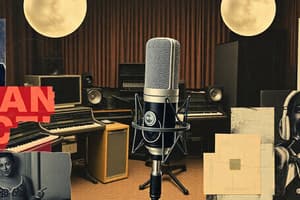Podcast
Questions and Answers
What is the main function of an audio production studio?
What is the main function of an audio production studio?
- To store audio equipment
- To provide training for audio engineers
- To conduct live broadcasts
- To assemble and create programming materials (correct)
What might a streamlined digital audio studio consist of?
What might a streamlined digital audio studio consist of?
- A computer and audio equipment in a designated workstation (correct)
- An isolated room with lower sound levels
- A traditional analog mixing board with various inputs
- A large audio console and multiple microphones
What is typically the purpose of the on-air studio in a radio station?
What is typically the purpose of the on-air studio in a radio station?
- To conduct interviews and live performances
- To facilitate live, day-to-day broadcasting (correct)
- To serve as a backup for production studios
- To create recorded content for later use
Which of the following types of content is typically created in an audio production studio?
Which of the following types of content is typically created in an audio production studio?
What is an essential characteristic of the production studio in relation to the on-air studio?
What is an essential characteristic of the production studio in relation to the on-air studio?
What are the primary concerns of studio design that are highlighted?
What are the primary concerns of studio design that are highlighted?
In what order does the audio signal typically flow in a production studio?
In what order does the audio signal typically flow in a production studio?
What layout do many audio production studios use to facilitate equipment operation?
What layout do many audio production studios use to facilitate equipment operation?
What is the purpose of signal-processing equipment in an audio chain?
What is the purpose of signal-processing equipment in an audio chain?
What type of recording gear is commonly found in a production studio alongside CD players?
What type of recording gear is commonly found in a production studio alongside CD players?
What is one primary benefit of stand-up studio designs compared to sit-down designs?
What is one primary benefit of stand-up studio designs compared to sit-down designs?
What is a key consideration when placing computer monitors in a studio?
What is a key consideration when placing computer monitors in a studio?
Which of the following statements about studio furniture is accurate?
Which of the following statements about studio furniture is accurate?
Which characteristic of sound allows for the breaking up of sound waves upon hitting irregular surfaces?
Which characteristic of sound allows for the breaking up of sound waves upon hitting irregular surfaces?
Which material is commonly used for manufacturing studio furniture for its aesthetic appeal and mounting options?
Which material is commonly used for manufacturing studio furniture for its aesthetic appeal and mounting options?
What does a coefficient value of 1.00 represent in sound absorption materials?
What does a coefficient value of 1.00 represent in sound absorption materials?
Which of the following materials has the highest absorption coefficient?
Which of the following materials has the highest absorption coefficient?
Why is a sound lock used in studio design?
Why is a sound lock used in studio design?
What is the effect of having parallel walls in a studio?
What is the effect of having parallel walls in a studio?
What issue arises from cubic construction in studio design?
What issue arises from cubic construction in studio design?
Which type of lighting should ideally be avoided in an audio production studio?
Which type of lighting should ideally be avoided in an audio production studio?
What is a common problem with studio stools during audio production?
What is a common problem with studio stools during audio production?
What defines reverb in a sound production context?
What defines reverb in a sound production context?
Which of the following describes excessive absorption in an audio studio?
Which of the following describes excessive absorption in an audio studio?
What is the purpose of diffusion in studio design?
What is the purpose of diffusion in studio design?
What is the function of reverb time in sound production?
What is the function of reverb time in sound production?
How does the live end/dead end design of a studio function?
How does the live end/dead end design of a studio function?
Which construction feature helps minimize outside sound penetration in a studio?
Which construction feature helps minimize outside sound penetration in a studio?
What is a common drawback of using carpeting on studio walls?
What is a common drawback of using carpeting on studio walls?
What does the term 'standing waves' refer to in audio production?
What does the term 'standing waves' refer to in audio production?
Flashcards are hidden until you start studying
Study Notes
The Studio Environment
- Audio production can happen in various environments, from field recording with simple setups to complex studio configurations.
- A production studio is a formal setting equipped with tools for creating finished audio content, like commercials and PSAs.
- Studios can vary in name (e.g., "Production 1," "Prod. B," "PDX") and may include multiple spaces for different purposes.
- Modern studios could be compact setups with computer and audio equipment, or larger configurations with extensive audio consoles.
The Audio Chain
- The audio chain outlines the interconnected path of audio equipment from sources, like microphones, to output systems for recording or broadcasting.
- Signal processing can occur throughout this chain and often involves equipment like mixers, equalizers, and multitrack recorders.
- Equipment complexity varies with studio size and budget, affecting how sound is manipulated and recorded.
- Monitoring is usually done through headphones or studio speakers.
Studio Layout
- Many studios adopt a U-shaped layout for accessibility and operators’ efficiency, placing all necessary controls within easy reach.
- The combo operation model has announcers also serving as equipment operators, merging roles in a single working space.
- Ergonomics is a key consideration, with sit-down versus stand-up designs affecting operator comfort and efficiency.
- Adjustable-height furniture enhances accessibility and comfort, promoting an energetic working environment.
Production Studio Furniture
- Studio furniture is essential for housing equipment and should be tailored to the studio's specifications for optimal function.
- Custom-built furniture can be expensive but offers precise dimensions, while modular systems provide flexibility for rearrangement.
- Modern studios integrate computer equipment alongside traditional audio equipment to streamline production.
- Proper placement of monitors and keyboards is crucial to prevent strain and ensure ergonomic efficiency.
Studio Sound Considerations
- The studio's physical characteristics significantly influence sound quality, with factors like isolation, noise control, and acoustics being vital.
- Sound behaviors include reflection, absorption, penetration, and diffusion, impacting how sound is produced and recorded.
- Direct sound reaches the microphone quickly, while reflected sound lags behind, influencing the overall audio quality.
- Managing sound characteristics involves balancing absorption (which quiets sound) and diffusion (which disperses sound) for clearer production.
Studio Construction Materials
- Effective sound isolation prevents unwanted external noise from entering and minimizes internal sound leakage.
- Soundproofing measures include heavy-duty doors, double-glazed windows, and acoustically treated walls to control sound reflection and absorption.
- Acoustic panels and specialized materials help maintain audio integrity by absorbing unwanted reverberations.
- Carpeting and less-effective treatments like egg cartons have historically been used, though modern solutions employ advanced designs for acoustical performance.### Sound Absorption Coefficient
- Sound absorption can vary significantly between materials, with coefficients ranging from 0.00 (no absorption) to 1.00 (complete absorption).
- Hard surfaces like plaster walls (0.04) and glass windows (0.12) have low absorption compared to materials like Sonex foam (0.81) and window curtains (0.75).
- Soundproofing aims to create a "dead" sound, minimizing reverb and echo.
Studio Design Considerations
- Studio design should minimize reflections to avoid harsh sounds; non-parallel walls help combat standing waves and excessive echo.
- Standing waves occur when sound waves reflect between parallel surfaces, leading to uneven audio.
- Studio dimensions should avoid cubic shapes to reduce frequency boosting and cancellation effects.
Studio Aesthetics
- Aesthetics in studio design improve user experience; avoid fluorescent lighting due to hum and glare.
- Lighting should be adjustable and comfortable; ergonomic furniture prevents noise from movement during recording.
- Decor elements like paintings and posters enhance the studio atmosphere.
Static Electricity Management
- Heavy carpeting in studios can increase static electricity, potentially disrupting equipment.
- Anti-static measures involve using sprays, fabric softeners, or conductive laminates to minimize static buildup.
On-Air/Recording Indicators
- On-air lights indicate live microphones; when lit, studio entry should be restricted and silence observed.
Communication in Studios
- Hand signals, though less common, are crucial for nonverbal communication during recordings, especially when microphones are live.
- Common signals include "standby," "cue talent," and timing cues for program lengths.
Noise and Distortion
- Noise is any unwanted sound added during production; a good signal-to-noise ratio is typically above 60 dB for analog and 98 dB for digital equipment.
- Distortion occurs when sounds are inaccurately reproduced—common causes include overdriven signals which produce muddy audio.
Sound and Audio Signals
- Sound signals result from natural sound (e.g., a voice), while audio signals arise from electronic manipulation (e.g., recordings).
- Understanding the difference helps navigate audio production processes effectively.
Sound Basics
- Sound is generated through vibrations and transmitted through mediums (usually air); sound waves consist of compressions and rarefactions.
- The sine wave is used to represent sound waves, showcasing their amplitude and frequency characteristics.
Sound Waveforms
- Frequencies, harmonics, and overtones combine to define timbre; sound waves can interact in-phase (amplifying) or out-of-phase (cancelling).
- Complex waveforms are a blend of various sound wave interactions, resulting in unique audio characteristics.
Sound Envelope
- The envelope of sound describes its volume changes over time and includes stages: attack, decay, sustain, and release.
- Manipulating sound envelopes is essential in postproduction to create desired audio effects.
Frequency Response
- Frequency response refers to the range of sound frequencies that audio equipment can reproduce effectively, impacting overall audio quality.### Human Ear Frequency Range
- The human ear typically hears frequencies from 20 Hz to 20,000 Hz.
- Most individuals have a slightly limited range within this spectrum.
Audio Equipment Frequency Response
- Quality of audio equipment measured by frequency response.
- Monitor speakers can have a response of 40 Hz to 18 kHz, accurately reproducing those frequencies.
- Inexpensive microphones may only respond between 80 Hz and 13 kHz, inadequate for higher frequencies.
Importance in Audio Recording
- Human voice typically ranges from 200 Hz to 3,000 Hz, making narrower frequency microphones suitable for speech.
- For musical recordings covering a wider range, better microphones with an extensive frequency response are necessary.
Frequency Response Curve
- Frequency response curves illustrate how well equipment picks up different frequencies.
- Broadcast equipment ideally has a flat frequency response, although few achieve true flatness.
Audio Frequency Spectrum
- Divided into three regions: bass, midrange, and treble:
- Bass: 20 to 250 Hz; provides power; imbalance leads to thin or boomy sounds.
- Midrange: 250 Hz to 4,500 Hz; adds substance and intelligibility; too little can lead to lack of presence, too much can create harshness.
- Treble: 4,500 Hz to 20,000 Hz; gives brilliance and sharpness; imbalance results in dullness or excessive sparkle and hissing.
Musical Intervals and Octaves
- Auditory perception varies in octaves, which involve doubling or halving frequencies.
- Example of octave progression: 110 Hz to 220 Hz to 440 Hz and so on.
Equal Loudness Principle
- Perception of loudness is influenced by pitch; midrange frequencies are heard better than high or low frequencies.
- Audio production often includes equalization to balance levels across frequencies.
Audio Production Environment
- Lack of control over studio construction can be offset with sound treatment techniques.
- Familiarity with the audio studio grows with practice and learning equipment operation techniques.
Studying That Suits You
Use AI to generate personalized quizzes and flashcards to suit your learning preferences.




